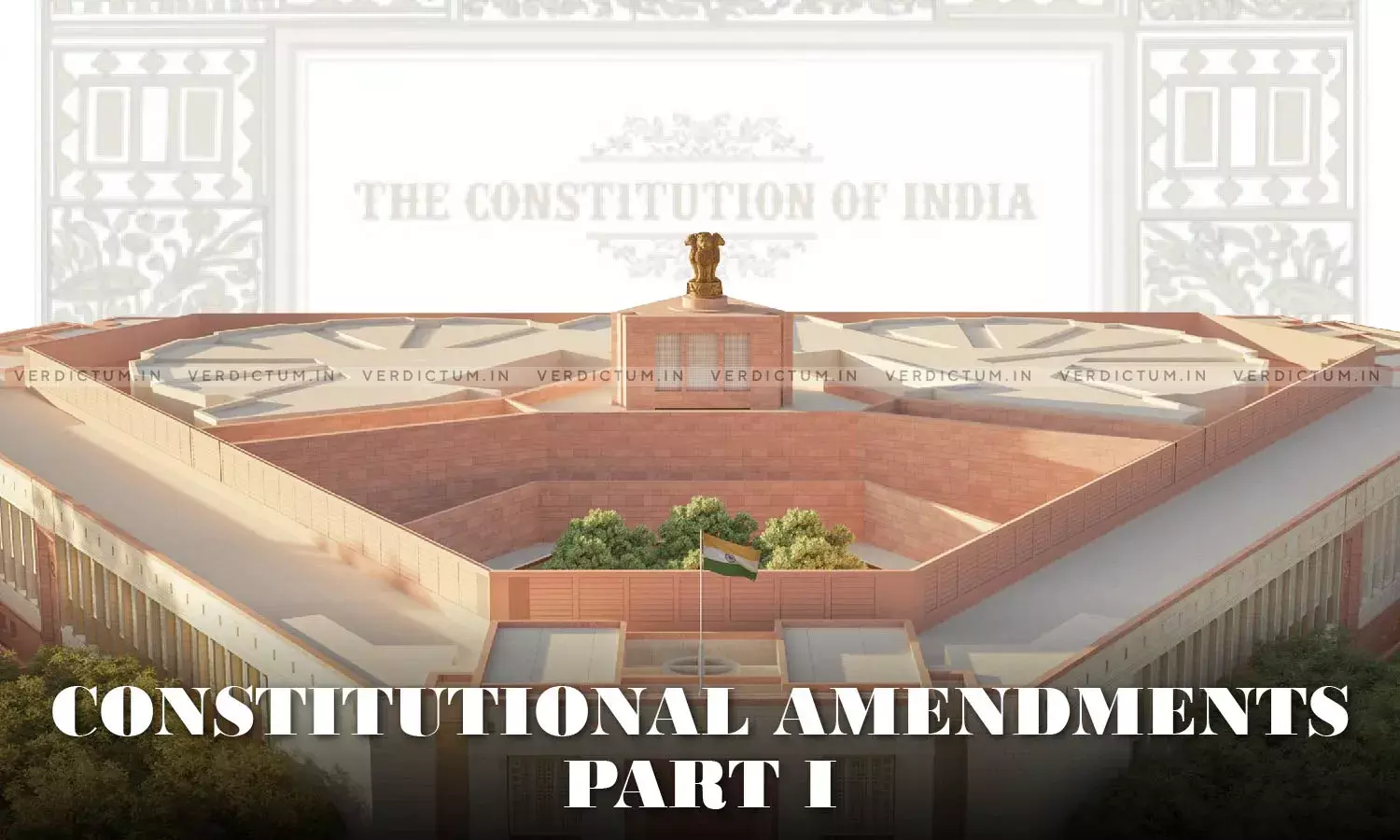Constitutional Amendments: From Its Lengthy Genesis To The First Amendment And Beyond
Part I of a series.
A distinctive document with extraordinary features, the Constitution of India holds the distinction of being the longest-written constitution among sovereign nations. Enacted on January 26, 1950, India's Republic Day, it consists of 395 articles in 22 parts and eight schedules. The Constitution establishes the executive, legislature, and judiciary, defines their powers and responsibilities, and regulates interstate relationships. It serves as the foundation of governance, ensuring the rights and duties of citizens while promoting justice, liberty, equality, fraternity, and the unity and integrity of the nation. The Constitution symbolizes people's power, as stated in the opening and closing sentences of the preamble. Crafted during a period of intense struggle for independence, it aimed to unite a diverse and divided nation, foster democratic institutions, and drive progress. The Constitution's drafting took place between December 1946 and November 1949, involving extensive discussions and revisions in the constituent assembly of India.
The Indian constitution was enforced in 1950, and in the very next year, an amendment was introduced. We amended the Indian constitution even before the first elections were held in Independent India. There were three fundamental changes made in the Constitution through this amendment. It gave ways to limit freedom of speech and expression, implemented important measures to abolish the Zamindari system, and made it clear that the right to equality does not preclude passing laws that give particular consideration to society's most vulnerable groups.
The Constitution's First Amendment Bill 1951 was introduced in Parliament provisionally on May 12, 1951. The bill sought to amend articles 15, 19, 85, 87, 174, 176, 341, 342, 372, and 376 of the Constitution. It also inserted new articles 31A, 31B, and the 9th schedule to the Constitution. On a motion moved in the house on May 6 and adopted on May 18, 1951, the bill was referred to a select committee. The report of the select committee was presented to the house on May 25, 1951.
The committee suggested amendments to some of the clauses of the bill as introduced in the house. The bill was reported by the select committee and was considered by the house on May 29, 30, and 31, as well as June 1 and 2, with some modifications. It was passed on June 2, 1951. The First Amendment to the Indian Constitution was unique as it was enacted by the interim government.
The Constitution (First Amendment) Act, 1951, was passed to address various difficulties that arose due to the Supreme Court's decisions in various cases, such as the Ramesh Thapar case. In the case of Ramesh Thapar vs. The State of Madras, the Supreme Court struck down the provisions of the Madras Maintenance of Public Order Act, 1949, on the grounds that it violated the fundamental right to freedom of speech and expression provided in Part III of the Constitution. Similarly, in the case of Brijbushan vs. State of Delhi, the Supreme Court struck down the provisions of the East Punjab Public Safety Act, 1949, as they were violative of the fundamental right to freedom of speech and expression.
The Constitution (First Amendment) Act of 1951 imposed limitations on the freedom of speech and expression guaranteed under Article 19 of the Indian Constitution. Article 19 was amended to add three grounds of restrictions on freedom of speech and expression based on friendly relations with foreign states, public order, and incitement to an offence.
To better understand the First Amendment, we should also look at the context in which it took place. When the Constitution (First Amendment) Bill was introduced in the provincial Parliament, the Constitution had been in effect for close to 16 months. During that time, the citizens of India had approached the higher judiciary to protect their fundamental rights granted under the Constitution. In many of these cases, the courts upheld the fundamental rights as they were given and struck down laws passed by state legislators in the country.
When the bill was introduced, it faced serious opposition both in Parliament and outside of Parliament. Many members of Parliament criticized on the floor of the house the different provisions related to the curbs that would be placed on freedom of speech and expression. Parliament then sent the bill to be examined by a select committee of the house. The committee comprised senior members like Prime Minister Nehru, Law Minister Ambedkar, and opposition leaders like Shama Prasad Mukherjee.
When the committee gave its report, it included 16 pages of dissent notes from all opposition members of Parliament. In fact, the opposition to the amendment was so significant that even the President of India, Rajendra Prasad, expressed reservations about the way in which the amendment was being carried out. On the floor of the house, members of Parliament questioned whether the provincial Parliament had the right to amend the Constitution or if it should wait for an elected legislature to come in and then amend the Constitution.
The amendment paved the way for reservation in India to address lost opportunities. Due to the practice of caste discrimination, reservations became a part of India's affirmative action initiative after independence. The Constitution's First Amendment Act of 1951 grants powers to the states to make special provisions for the advancement of socially and economically backward classes.
Article 15 was amended by the Constitution's First Amendment Act of 1951, and Clause 4 was added to Article 15, allowing the state to make reservations for Scheduled Castes and Scheduled Tribes in educational institutions. Reservations were implemented in the Indian Constitution immediately after independence as a means to acknowledge the historical injustice suffered by people belonging to backward groups and to create provisions that would provide them with better access to resources and opportunities.
Reservations in India were introduced to rectify past and historical injustices against the backward classes, ensuring equal representation and providing an equal platform for everyone, regardless of their caste, to promote and advance the backward classes.
A clause was added to Article 15, Clause 4, which provided that the government can make special provisions in favour of socially and educationally backward classes of citizens or for Scheduled Castes and Scheduled Tribes. The question arises as to why this amendment was necessary. We need to examine this amendment in the context of Articles 14, 15, and 16 of the Constitution, as all three articles deal with the right to equality, which is enshrined in the Preamble of the Constitution itself.
The Preamble speaks of justice, social, economic, and political, and also mentions equality of status and opportunity. However, this cannot be achieved unless the principles enshrined in Part Four of the Constitution, which deals with Directive Principles of State Policy, are implemented. Therefore, Article 14 was further extended by Articles 15 and 16. Article 15 prohibits discrimination on the grounds of religion, race, caste, sex, or place of birth. Article 16 provides for equality of opportunity in public employment.
While framing Article 15, the Constituent Assembly made a special provision that an exception can be created for women and children. However, a similar kind of exception was not created for socially and educationally backward classes, as well as for Scheduled Castes and Scheduled Tribes. If they were to be brought on par with other people in society, it was necessary to provide them with a similar status to that given to women and children, allowing for special laws to be made for them. To achieve this objective and give effect to the Preamble of the Constitution and the Directive Principles of State Policy, an exception was created by adding Clause 4 to Article 15. This clause stated that the government can make special provisions in favour of socially and educationally backward classes of citizens or for Scheduled Castes and Scheduled Tribes.
Regarding the implementation of Directive Principles, we know that even that implementation must be done in accordance with and protecting the fundamental rights of the individual. Therefore, unless an exception is created within the article of fundamental rights itself, such a law or executive order could not have been passed by the state government. I believe this was a very good amendment made at that time because it enabled the government to formulate policies to protect the interests of women, children, as well as socially and educationally backward classes.
The Constitution (First Amendment) Act of 1951 added the Ninth Schedule to the Indian Constitution. The laws contained in the Ninth Schedule are immune from judicial review. The Ninth Schedule was created by the insertion of Articles 31A and 31B. Article 31A was inserted by the government in order to protect laws related to agrarian reform and the abolishment of the zamindari system. Article 31B of the Constitution of India provides that any law in the Ninth Schedule cannot be challenged in courts. Another feature of Article 31B is that it is retrospective in nature, meaning that when a law is declared unconstitutional by a court and later included in the Ninth Schedule, it is considered to have been in that schedule from its commencement. Thus, it provides blanket protection to all laws under the Ninth Schedule.
After Indian independence, during the implementation of land reforms and the abolition of the zamindari system, the Patna High Court struck down the Bihar Land Reforms Act of 1950. This dealt a severe blow to the idea of land reforms and the subsequent abolition of the zamindari system. It was a precarious situation because despite the country's desire to progress, judicial scrutiny and review hindered the implementation of laws. This troubled the leaders of that time and prompted the framers of the Constitution to consider how they could protect laws related to land reforms from judicial scrutiny. As a result, the first constitutional amendment was introduced in 1951.
The Constitution (First Amendment) Act of 1951, also known as the first amendment, introduced Article 31B, which established the Ninth Schedule in the Indian Constitution. Article 31B was introduced to safeguard certain laws enacted by the central and state governments from judicial scrutiny and review. These laws were to be placed in the Ninth Schedule. Consequently, the Bihar Land Reforms Act of 1950, along with other Land Reform Acts, was included in the Ninth Schedule. This arrangement ensured that the courts of that time could not strike down or declare these laws unconstitutional, allowing the country to progress through governance.
Presently, the Ninth Schedule protects 284 laws of the country. This means that laws enacted by Parliament cannot be subjected to judicial scrutiny or review by the Supreme Court or any other courts. However, it is important to note that there have been different judgments by the Supreme Court, including the Kesavananda Bharati case, which discussed the basic structure of the Constitution. As parliamentarians, when we consider making laws, there are instances where the honorable courts strike them down, particularly the Supreme Court. However, the Ninth Schedule ensures that laws enacted by Parliament receive reasonable safeguards and protection, serving the greater good of the nation by ensuring the preservation of certain laws.
The Constitution (First Amendment) Act of 1951 also stipulated that the state's trading and nationalization of any trade or business would not be considered a violation of the right to trade or conduct business, provided that it adheres to certain conditions. These conditions include being in the interest of state security, maintaining amicable relations with foreign states, preserving public order, preventing contempt of court, preventing incitement to commit an offense, or preventing defamation.
Now, Article 19 also grants the freedom to practice any trade, business, or profession. However, when the Constitution was originally drafted, a reasonable restriction was placed that these activities should be carried out in the general public interest. While the government was optimistic that the existing provisions permitted state governments to undertake nationalization schemes, it wanted to ensure that such schemes would not be invalidated by the courts. Therefore, an exception was created that allowed the government to implement comprehensive nationalization schemes without the risk of them being struck down by the courts.
Every constitution incorporates methods for alteration, allowing provisions to be modified through expansion, rectification, or revision to suit the present requirements. The framers of the Indian constitution were fully aware that changes would be necessary over time. Therefore, provisions for amending the Constitution were included to address future challenges. The constitution's authors aimed to create a flexible constitution, avoiding excessive rigidity in the Indian Constitution. Their intention was to have a constitution that could evolve alongside the nation's development and adapt to the changing needs of its people. The success of the Indian constitution, considering the diversity and complexity of India, continues to intrigue, impress, and inspire experts worldwide.
Author is an Advocate practicing in the High Court of Bombay.
[The opinions expressed in this article are those of the author. Verdictum does not assume any responsibility or liability for the contents of the article.]












